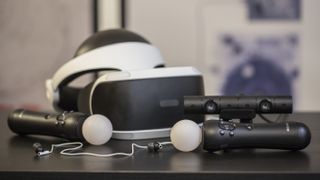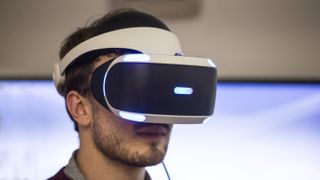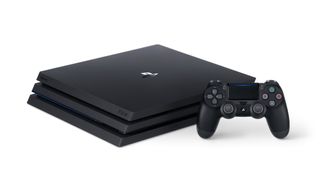
Update: Sony recently admitted that PlayStation VR sales haven't met the company's projections, despite the headset dominating the high-end virtual reality space with 2 million units sold.
One avenue of speculation is that the PSVR 2 will tie into the PlayStation 5 release as the headset could take advantage of the new console's upgraded hardware. As for the headset itself, it's possible it could house an ultra-high resolution display manufactured that boasts 1,001 pixels per inch.
That's not all we're hearing about the PSVR 2, so for more on the headset, check out our dedicated PlayStation VR 2 hub.
If don't want to wait for the PlayStation VR 2, you can't go wrong with the current headset. There's plenty of content to play, so check out our round up of the best PlayStation VR games of the year!
Original article continues below...
PlayStation VR brings the world of virtual reality to consoles in a big way, and it does so without the cost most often associated with rival higher-end VR headsets.
Those headsets have not only traditionally been expensive devices on their own, but have also required expensive gaming PCs with enough power to run them.
Well over a year after its release, the PlayStation VR virtual reality headset is still going strong. Sony is positively committing to its VR development teams, as evidenced by the quality PlayStation VR games that have been released, and those yet to come.
Moss just launched in February, and two more must-play titles – The Inpatient and Sprint Vector – are also out now. What's more, Sony announced more than 30 games coming to PlayStation VR in spring 2018, or sometime between late March and mid-June. We expect to get a big preview of these games at E3 2018.
To cap it all off, a revised headset was also released in late 2017 to address the original headset's lack of HDR-passthrough. The future's bright for Sony's VR gear.
Let's put it this way: the PlayStation VR is different. While Oculus Rift has closed in on cost, the PSVR only requires a PS4 console to run, not an expensive PC set-up.
Frankly, it's remarkable that such an affordable solution is as capable as it is.
It has its problems, but by and large PlayStation VR proves that not only is console VR viable, it's actually enjoyable, too.
We've now tried dozens of games on the console, from Rocksteady's impressive (but short) Batman: Arkham VR to the laugh-out-loud funny Job Simulator to the tear-jerking Wayward Sky and even gun-peripheral-toting horror game Farpoint VR.
Some of these titles were more fun than others, obviously, but all of them made the same point: PlayStation VR doesn't suck.
Before we go on talking about PlayStation VR's finer points (and foibles), let's get the basics out of the way.
At launch, the PlayStation VR headset had a slightly confusing sales set up. With the package re-using existing PlayStation peripherals such as the Move controllers and Camera, the PSVR headset itself was sold separately in some instances, despite the other components being vital parts of the set-up.
If you didn't already own the PlayStation Camera or Move Motion Controllers, the Launch Day bundle was the better bet, but more than a year on and the bundles – and messaging around exactly what components you'll need – are much better.
As of March 29, you can find PlayStation VR DOOM VFR bundle for $299.99 in the US, which includes the headset,camera, and a DOOM VFR Blu-ray disc. There's also a Skyrim VR bundle for $349.99. Both of these prices are $100 less than their original listing price.
In the UK, meanwhile, a starter pack costs £259, down from £349. In Australia, the same pack is priced AU$549.
Besides the PlayStation VR unit itself and the PlayStation Camera, all you'll need is a PS4 (either the Slim version, the three-year-old original or the ultra-powerful PS4 Pro will do), a PS4 DualShock 4 controller and a 6-foot-by-10-foot play space that's well lit, but not too bright.
Setting up the unit can be done in a matter of minutes and the provided instructions offer a clear visual guide to get you up and running.
How does PlayStation VR work?
Like other virtual reality headsets on the market, PlayStation VR has the arduous task of completely immersing you in a video game by producing two images simultaneously and then sending them to a headset a few feet away. But unlike the competition who require expensive graphics cards to get the job done, PS VR can do it using only the PlayStation 4's built-in GPU.It achieves this by using the PlayStation Camera to track nine different points of light on the headset and the lights on either the Move controllers, or on the DualShock 4, depending on which game you're playing.
It's surprisingly accurate given the fact that it's only using a single camera to track what's happening ... but it's not foolproof by any stretch of the imagination. We'll cover performance in detail in a minute, but be prepared for the camera to lose track of the controllers. A lot.
But the real bummer here is that because Sony only uses one camera instead of two, it's harder for PlayStation VR to track you if you get up and walk around than it is for a system like the HTC Vive which can offer true room-scale VR. That said, it still can support you if you decide to get up and wander around, but don't expect to take more than a few steps in any direction without a warning from the system that you're straying too far away.
To that end, most PlayStation VR games can recommend that you stay in one of two positions, either sitting down or standing up and stationary. If you're prone to motion sickness, sitting down might be a bit more comfortable, however, certain games are definitely better played on your feet.

But let's back up. Up until now, the words "VR" and "virtual reality" have been thrown around a lot without much explanation.
VR has existed in one form or another for decades, but the modern version of the technology is more immersive and less nausea-inducing than it's ever been. In more or less words, virtual reality is just that – a virtual world that gives you the experience of being somewhere else in a different time, at a different place, sometimes as far as an alien world, all without ever leaving your home.
And yes, it's just as cool as it sounds.
If you want to be specific about it, PlayStation VR can handle 1080p games on its 920 x RGB x 1080 OLED display at either 90Hz (meaning that the image refreshes itself 90 times per second) or at 120Hz depending on the VR game or application.
And for those concerned about latency, Sony says that PlayStation VR's response rate is locked in at around 18ms – which is about 0.002 seconds faster than the highest acceptable latency before you would notice the lag in VR.
Those numbers are great, but they're matched by both the HTC Vive and Oculus Rift. The one advantage Sony has that neither Oculus nor HTC can claim is that it's actually a world-class game publisher. While the other two have been trying to create connections with developers over the past few years, Sony already has them.
As a result, the best PlayStation VR games list is being constantly updated with excellent fresh experiences, with plenty more set to come across the next year. From shooters to puzzlers, platformers to narrative adventures, there's variety and depth to PSVR's growing gaming catalogue.

PlayStation VR on PS4 Pro
There's also another piece of hardware to consider when looking at buying a PlayStation VR, and that's Sony's brand-new, ultra-powered PS4 Pro.With additional processing power, the PS4 Pro is capable of creating an even more immersive virtual reality experience for the games that support it.
The improvements PS4 Pro promises can take many forms – from more detailed textures to better draw distances, and even a small reduction in graininess. The advantages differ from game-to-game, and PS4 Pro is currently setup to only support games where the developer has enabled "Pro Mode", a hardware boosting technology that tells the PS4 to use extra processing power.
While writing the PS4 Pro review, we got the chance to try the upgraded hardware with the PlayStation VR and the results were noticeable, if a bit underwhelming in reality.
There's definitely a distinct difference between PS4 and PS4 Pro versions of VR games, however, it's probably not one that can be spotted by the unwitting non-techie – it's something that you can only spot if you're paying close attention to how certain textures look in-game or how objects look in the distance. Lag felt less prevalent on the Pro system though, in all fairness, it wasn't something we felt was a major problem while using the standard issue console.
Whether the minor improvements are worth paying extra for the more powerful hardware is ultimately a decision we'll leave up to you, however it's our opinion that you can get by with a standard PS4 just fine.
.
ليست هناك تعليقات:
إرسال تعليق